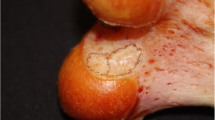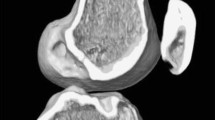Abstract
Introduction
Successful anterior cruciate ligament (ACL) reconstruction is dependent on correct placement of both tibial and femoral tunnels. The purpose of this study is to investigate whether we can use intraoperative femoral tunnel length measurement to estimate the correct femoral tunnel placement on coronal plane.
Methods
This prospective study comprised 164 consecutive patients who underwent ACL reconstruction surgery. Transtibial or anteromedial portal technique is used for drilling the femoral tunnels. The length of the femoral tunnel was measured during the operation. The femoral tunnel coronal plane angle was calculated on the postoperative tunnel radiographs. A statistical comparison was made of the lengths of the tunnel, the techniques used drilling and the femoral tunnel angles.
Results
The far anteromedial portal was used in 81 (49 %) cases and the transtibial technique in 83 (51 %) cases. The mean femoral tunnel length was 42 ± 6.4 mm and the mean femoral tunnel coronal angle was 41.1° ± 11.6. The tunnel angle in the transtibial technique was determined as significantly low compared to the far anteromedial portal technique (32.6°:49.8°) and the tunnel length was significantly longer (45.8:38.1 mm) (p < 0.001). In the statistical analysis, it was found that a patient with a tunnel length of 41 mm and above had a 92.1 % likelihood of femoral tunnel angle below 45°.
Conclusion
Femoral tunnel length can be used as a clue for intraoperative evaluation of the femoral tunnel position. If the femoral tunnel length is greater than 41 mm, the coronal plane orientation of the femoral tunnel will be improper and not at a desired position.


Similar content being viewed by others
References
Hefzy MS, Grood ES, Noyes FR (1989) Factors affecting the region of most isometric femoral attachments. Part II: the anterior cruciate ligament. Am J Sports Med 17:208–216
Klos TV, Harman MK, Habets RJ, Devilee RJ, Banks SA (2000) Locating femoral graft placement from lateral radiographs in anterior cruciate ligament reconstruction: a comparison of 3 methods of measuring radiographic images. Arthroscopy 16:499–504
Musahl V, Plakseychuk A, Van Scyoc A, Sasaki T, Debski RE, McMahon PJ, Fu FH (2005) Varying femoral tunnels between the anatomical footprint and isometric positions: effect on kinematics of the anterior cruciate ligament-reconstructed knee. Am J Sports Med 33:712–718
Markolf KL, Hame S, Hunter DM, Oakes DA, Zoric B, Gause P, Finerman GA (2002) Effects of femoral tunnel placement on knee laxity and forces in an anterior cruciate ligament graft. J Orthop Res 20:1016–1024
Rupp S, Muller B, Seil R (2001) Knee laxity after ACL reconstruction with a BPTB graft. Knee Surg Sports Traumatol Arthrosc 9:72–76
Bedi A, Raphael B, Maderazo A, Pavlov H, Williams RJ III (2010) Transtibial versus anteromedial portal drilling for anterior cruciate ligament reconstruction: a cadaveric study of femoral tunnel length and obliquity. Arthroscopy 26(3):342–350
Lee MC, Seong SC, Lee S, Chang CB, Park YK, Jo H, Kim CH (2007) Vertical femoral tunnel placement results in rotational knee laxity after anterior cruciate ligament reconstruction. Arthroscopy 23(7):771–778
Loh JC, Fukuda Y, Tsuda E, Steadman RJ, Fu FH, Woo SL (2003) Knee stability and graft function following anterior cruciate ligament reconstruction: comparison between 11 o’clock and 10 o’clock femoral tunnel placement Richard O’Connor Award paper. Arthroscopy 19(3):297–304
Dargel J, Schmidt-Wiethoff R, Fischer S, Mader K, Koebke J, Schneider T (2009) Femoral bone tunnel placement using the transtibial tunnel or the anteromedial portal in ACL reconstruction: a radiographic evaluation. Knee Surg Sports Traumatol Arthrosc 17(3):220–227
Basdekis G, Abisafi C, Christel P (2008) Influence of knee flexion angle on femoral tunnel characteristics when drilled through the anteromedial portal during anterior cruciate ligament reconstruction. Arthroscopy 24:459–464
Golish SR, Baumfeld JA, Schoderbek RJ, Miller MD (2007) The effect of femoral tunnel starting position on tunnel length in anterior cruciate ligament reconstruction: a cadaveric study. Arthroscopy 23:1187–1192
Azzam MG, Lenarz CJ, Farrow LD, Israel H, Kieffer D, Kaar SG (2011) Inter- and intraobserver reliability of the clock face representation as used to describe the femoral intercondylar notch. Knee Surg Sports Traumatol Arthrosc 19(8):1265–1270
Steiner ME, Murray MM, Rodeo SA (2008) Strategies to improve anterior cruciate ligament healing and graft placement. Am J Sports Med 36:176–189
Hohmann E, Bryant A, Tetsworth K (2010) Tunnel positioning in anterior cruciate ligament reconstruction: how long is the learning curve? Knee Surg Sports Traumatol Arthrosc 18:1576–1582
Yamazaki J, Muneta T, Koga H, Sekiya I, Ju Y-J, Morito T et al (2011) Radiographic description of femoral tunnel placement expressed as intercondylar clock time in double-bundle anterior cruciate ligament reconstruction. Knee Surg Sports Traumatol Arthrosc 19:418–423
Howell SM, Taylor MA (1993) Failure of reconstruction of the anterior cruciate ligament due to impingement by the intercondylar roof. J Bone Joint Surg Am 75(7):1044–1055
Zavras TD, Race A, Bull AM, Amis AA (2001) A comparative study of ‘isometric’ points for anterior cruciate ligament graft attachment. Knee Surg Sports Traumatol Arthrosc 9(1):28–33
Jepsen CF, Lundberg-Jensen AK, Faunoe P (2007) Does the position of the femoral tunnel affect the laxity or clinical outcome of the anterior cruciate ligament-reconstructed knee? A clinical, prospective, randomized, double-blind study. Arthroscopy 23:1326–1333
Rue JP, Ghodadra N, Lewis PB, Bach BR Jr (2008) Femoral and tibial tunnel position using a transtibial drilled anterior cruciate ligament reconstruction technique. J Knee Surg 21:246–249
van Eck CF, Martins CA, Vyas SM, Celentano U, van Dijk CN, Fu FH (2010) Femoral intercondylar notch shape and dimensions in ACL-injured patients. Knee Surg Sports Traumatol Arthrosc 18:1257–1262
Wright RW, Huston LJ, Spindler KP, Dunn WR, Haas AK, Allen CR, Cooper DE, DeBerardino TM, Lantz BB, Mann BJ, Stuart MJ (2010) Descriptive epidemiology of the multicenter ACL revision study (MARS) cohort. Am J Sports Med 38(10):1979–1986
Scopp JM, Jasper LE, Belkoff SM, Moorman CT III (2004) The effect of oblique femoral tunnel placement on rotational constraint of the knee reconstructed using patellar tendon autografts. Arthroscopy 20(3):294–299
Giron F, Cuomo P, Aglietti P, Bill AMJ, Amis AA (2006) Femoral attachment of the anterior cruciate ligament. Knee Surg Sports Traumatol Arthrosc 14(3):250–256
Lopez-Vidriero E, Johnson D (2009) Evolving concepts in tunnel placement. Sports Med Arthrosc Rev 17:210–216
Lubowitz JH (2009) Anteromedial portal technique for the anterior cruciate ligament femoral socket: pitfalls and solutions. Arthroscopy 25:95–101
Khalfayan EE, Sharkey PF, Alexander AH, Bruckner JD, Bynum EB (1996) The relationship between tunnel placement and clinical results after anterior cruciate ligament reconstruction. Am J Sports Med 24:335–341
Lintner DM, Dewitt SE, Moseley JB (1996) Radiographic evaluation of native anterior cruciate ligament attachments and graft placement for reconstruction. A cadaveric study. Am J Sports Med 24:72–78
Sommer C, Friederich NF, Muller W (2000) Improperly placed anterior cruciate ligament grafts: correlation between radiological parameters and clinical results. Knee Surg Sports Traumatol Arthrosc 8:207–213
Giron F, Buzzi R, Aglietti P (1999) Femoral tunnel position in anterior cruciate ligament reconstruction using three techniques. A cadaver study. Arthroscopy 15:750–756
Conflict of interest
None.
Author information
Authors and Affiliations
Corresponding author
Rights and permissions
About this article
Cite this article
Celiktas, M., Kose, O., Sarpel, Y. et al. Can we use intraoperative femoral tunnel length measurement as a clue for proper femoral tunnel placement on coronal plane during ACL reconstruction?. Arch Orthop Trauma Surg 135, 523–528 (2015). https://doi.org/10.1007/s00402-015-2173-2
Received:
Published:
Issue Date:
DOI: https://doi.org/10.1007/s00402-015-2173-2




